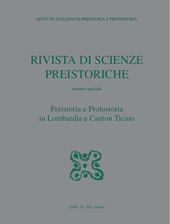Santuari e percorsi rituali dell'età del Ferro nella Valle del Chiese
P. 765-775
During a research project in mountain regions in the municipal areas of Gavardo, Villanuova sul Clisi, Vallio, Agnosine and Sabbio Chiese (BS) coordinated by the then Lombardy Archaeological Heritage Superintendency, a series of sites with distinctive features were found. They are located on areas of high ground and have yielded finds dating from the First Iron Age to the Roman period. The nature of these – mostly metal – objects and the sites' topographical and structural characteristics suggests that this was a group of ritual areas, situated among the hills on pathways that are still used. The distribution pattern appears to show a hierarchy of sites, with structured principal locations and satellite areas. After the discovery of these sites (2004 – 2011) several were investigated by means of archaeological excavation.
The largest and most complex, Dos della Rocchetta - Rasine (Sabbio Chiese), was a limestone hill with suggestive karst erosion features: cavities, fissures, arches, small rock shelters, sinkholes and large detached bodies of rock. On the upper plateau a rectangular area has been cut into the rock surface. Here and on the higher crags many metal objects were found (mostly in bronze, complete or broken), together with a much smaller quantity of scorched potsherds, and widespread small burnt bone fragments. The metal artefacts included various kinds of bronze fibula, torc and pendant, silver coins and items in iron. During the final phase of use iron shoetacks are particularly numerous. Around the main site several smaller sites have been identified, at one of which was found an exceptional bronze artefact with an inscription in the ancient alphabet of the Camunni.
Smaller sites have been found north of the village of Oriolo (Vallio Terme) and in the Monte Magno area (Gavardo). Study of these contexts – taking into account the constructions present, the natural features chosen, the differing preservation states of the finds and their spatial distribution – has yielded interesting conclusions regarding the rituals conducted in these sanctuaries, which were similar in some respects to those of the brandopferplätze of Alpine tradition. [Publisher's text]
-
Articoli dello stesso fascicolo (disponibili singolarmente)
-
Informazioni
Codice DOI: 10.32097/1208
ISSN: 2282-457X


